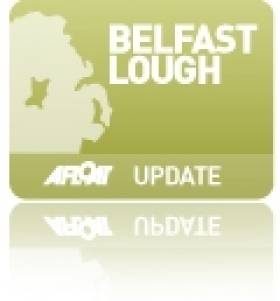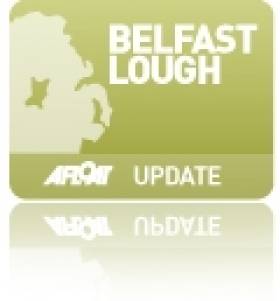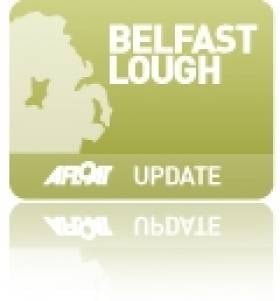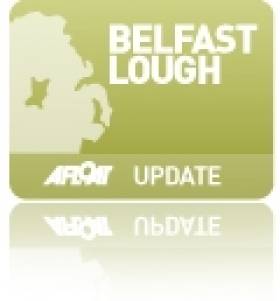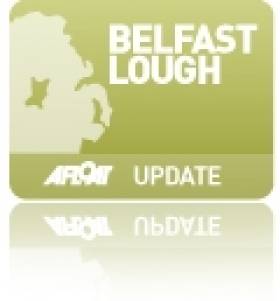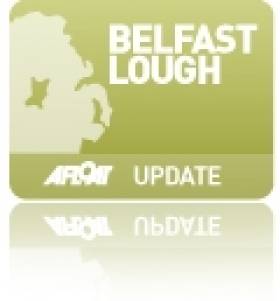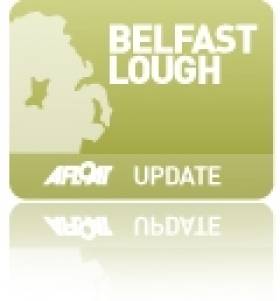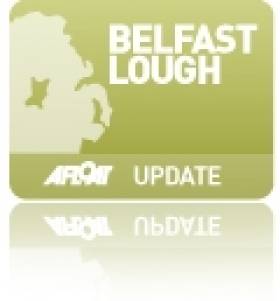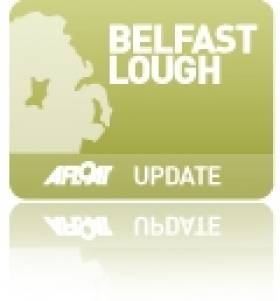Displaying items by tag: Belfast Lough News
S.S. Nomadic Taken Over by Titanic Belfast
#TitanicsTender - The tender, SS Nomadic built alongside Titanic at Harland and Wolff shipyards, carried first and second-class passengers from Cherbourg onto the liner as she embarked on its maiden voyage.
According to Belfast Live, the SS Nomadic is being taken over by Titanic Belfast more than a century after it ferried passengers to the ill-fated liner.
The historic vessel, often referred to as 'Titanic's little sister', is the last remaining White Star ship. It is also the biggest artefact in the world with links to the famous liner.
The tender, built alongside Titanic at Harland and Wolff shipyards, carried first and second-class passengers from Cherbourg onto the liner as she embarked on its maiden voyage.
Built in 1911, it has enjoyed a colourful history. It served in both world wars and has also been used as a floating restaurant, a nightclub and a casino.
To read more on the tender's story, click here.
Belfast Harbour’s New Chairman Sets Out Vision for Port
#NewChairman - Belfast Harbour has a new chairman, David Dobbin, who has been on the port's board from 2012, made his first statement since his appointment last month.
Taking the helm of the harbour's new pilot boat, built by local boat builder Red Bay Boats, Dobbin took the opportunity to set out his vision for the business.
"Belfast Harbour is first and foremost a major port which makes a vital contribution to Northern Ireland's economy handling almost three quarters of all of Northern Ireland's sea borne trade. As the incoming Chairman I am committed to ensuring that Belfast continues to be the most modern and efficient port on the island. With over 23 million tonnes of cargo and 1.4 million ferry and cruise ship passengers passing through the Port annually, it is Northern Ireland's primary gateway to rest of the world.
To read more of his statement, click here.
Belfast Harbour ‘Bulked-Up’ by Record Tonnage Growth
#RecordTonnage - Belfast Harbour trade figures reveal that the port handled a record 23 million tonnes during 2014, up 46% since the recession's low point in 2009.
Overall tonnages rose by 1.6%, driven by strong growth in bulk cargo which accounts for over 40% of throughput at the Harbour. Trade sectors which grew particularly well included stone exports (18%), industrial and domestic coal (20%), paper products (33%) and steel (38%).
A record 476,000 freight vehicles also passed through the Harbour during 2014 (up over 2%), while container traffic improved by 2.9% to 125,000 units. The level of new car imports also rose by 10% to 48,000, its highest level since 2007.
Roy Adair, Belfast Harbour's CEO, said: "Surpassing 23 million tonnes for the first time is a major achievement for the Harbour, driven by our ongoing investment programme to deliver best-in-class facilities. It has also been supported by major investments from customers such as Stena Line which has introduced a third ship to its Belfast – Liverpool service.
"Improving economic and consumer confidence across the island has helped drive growth. Increased steel imports, for example, reflects greater manufacturing activity, especially in the Republic of Ireland, while the improvement in freight, containers and new car imports suggests a modest pick-up in consumer confidence.
"As the economy across the island has improved, so too has competition in the port sector. Belfast Harbour is actively pursuing a pipeline of new capital expenditure projects valued at £140m to support further economic growth across the Harbour Estate and to develop new and existing trade opportunities, ensuring that local businesses have access to world class facilities."
The Harbour's animal feed sector performed well, rising 3.3% to a record 2.2m tonnes, while scrap exports rose 14% to a record 373,000 tonnes.
Cement tonnages also improved, increasing fivefold to 79,000 tonnes. This was, however, from a small base and total cement tonnages remain less than one third of pre-recession levels.
Joe O'Neill, Belfast Harbour's Commercial Director said: "Exports from Belfast Harbour grew by 3.6% in 2014, accounting for 42% of all tonnages handled. In 20-years tonnages at Belfast Harbour have grown almost fourfold thanks to a rolling programme of Harbour investment totalling £400 m which has helped develop trade and attracted new business activity in the Harbour Estate.
"A major contributor to that success was Northern Ireland-based quarry firm, Conexpo, which grew its stone exports by 25% to almost one million tonnes in 2014 to meet demand from customers in GB and Europe.
"Conexpo is a good example of a SME whose export growth plans have been supported by Belfast Harbour's investments in new equipment and quays, and the availability of ever larger premises within the Harbour Estate. Our focus over the next 20-years is to ensure that the Harbour continues to grow and invest to support similar success stories."
Ferry passenger numbers remained steady during 2014 at 1.4m while cruise passengers calling at Belfast increased by 23% to a record 112,000.
Harland & Wolff Awarded Rig Contract Amid Strong Recruitment Drive
#RigContract - Harland and Wolff (H&W) has announced a contract to dry dock and provide a Renewal / Special Periodic Survey of the rig Byford Dolphin.
The contract of the Mobile Offshore Drilling Unit (MODU) was from Aberdeen-based Dolphin Drilling Limited.
Following the Belfast ship-repair and marine engineering's facility in completing its sister rig as previously reported on Afloat.ie, the Blackford Dolphin in 2014, the Byford project is expected to start early this year.
H&W and Dolphin Drilling will implement an integrated project organisation dedicated solely to the execution of the project covering the many disciplines, aspects and subcontractors of the scope.
The Aker-H3 design semi-submersible drilling rig which in Belfast in 2004-2005, will have several major modifications and upgrades including the fabrication and addition of 2 new columns and 4 buoyancy boxes for stability and deck load improvements.
In addition to the fitting of a new larger blow out preventer (BOP) requiring underdeck stiffening and the fabrication and installation of a new BOP control house and installation of new drill string handling equipment.
The project will also include numerous standard renewal and maintenance scopes of work such as repairs, renewals and refurbishment of pipework, steelwork, anodes, drilling equipment, electrical systems, propulsion machinery and accommodation areas.
H&W have already begun a 3-month period of pre-fabrication where new steel sections will be constructed in advance of the rig arrival.
Director of Ship and Offshore Unit Repair, James Lappin, said "This is a significant project for Harland and Wolff and for Northern Ireland. As well as employment opportunities, the supply chain within Northern Ireland will see significant activity in support of the project. Local engineering firms will have subcontract opportunities for manufacture and supply of services, suppliers will provide vast quantities of materials, hotels and hospitality will accommodate the hundreds of specialist sub-contractors that follow these large contracts, wherever they are awarded. In short, tens of millions of pounds will flow through the local economy."
Graeme Murray, Managing Director of Dolphin Drilling Limited, said "We are pleased to build upon the relationship with Harland and Wolff following the work completed on the Blackford Dolphin and look forward to delivering the Byford back into service following a successful renewal survey, on time and within budget."
Encouraged by strong performances in the offshore oil, gas and renewable energy sectors, H&W have been enacting a strong recruitment drive that will take its permanent staff levels up by over 60 people.
This strengthening is across the entirety of H&W workforce and the process is expected to conclude Q2 2015 and compliments the Company's ongoing Apprenticeship and Graduate Development Programmes.
Chief Executive Officer, Robert Cooper, said "We are pleased to continue our investment in the strength, capability and capacity of our Company. The expectations of our customers are of utmost importance to us, and this investment demonstrates our commitment to meeting those expectations."
Boutique Hotel A Step Closer for Titanic Quarter
#BoutiqueHotel - In the Titanic Quarter, a luxury hotel employing 75 people, has come a step closer, it can be revealed reports the Belfast Telegraph.
The flagship 84-bedroom four-star 'boutique' development will be based at the old Harland & Wolff headquarters and Drawing Offices.
It's understood the new development could be worth around £27m.
And as many as 250 additional jobs could also be created through the hotel's construction.
It's also understood there are at least three other applications under way for similar developments in the area.
Planning permission had already been approved for a 111-bedroom hotel at the centre of the city's expanding Titanic development.
For much more on the waterfront development story, click HERE
#GreenAward – The highest scoring level of platinum status has been achieved by Belfast Harbour, in this year's Northern Ireland Environmental Benchmarking Survey.
Now in its sixteenth year, the Survey, generated by Business in the Community's ARENA Network campaign and supported by the Northern Ireland Environment Agency and Charles Hurst Fleet Financial, annually assesses top businesses in Northern Ireland for environmental management, performance and assurance.
104 organisations participated this year and the average overall score decreased from 77% in 2013 to 74% but only 4% of this year's respondents scored less than 40%. The decline in the average score was expected as the Survey underwent an overhaul, demanding tougher calls to provide evidence and a clear focus on corporate strategy.
Environment Minister Mark H Durkan said: "Too many people think creating a better environment means weakening our economy, the challenge of the 21st Century is to invent new ways to deliver excellent environmental performance and create prosperity. The Benchmarking Survey highlights the need for businesses to see the environment as an opportunity and not a barrier. A reduction of environmental impacts through resource efficiency and investment in sustainable technologies, helps to grow their business.
"I praise each organisation who took part in this year's benchmarking Survey. They clearly show how businesses can take effective action within their own companies and champion good environmental stewardship".
The minister added "Through continued partnership between ARENA Network and the Northern Ireland Environment Agency, and with the help of businesses, we can lead the way in challenging and inspiring businesses to go beyond reporting, maintaining and setting targets. We want you to take the reins and go beyond what is required of responsible organisations and to move forward and bring your supply chains with you. Invest, innovate, share and build partnerships."
Belfast Harbour's Safety and Environmental Manager David Knott said: ""This is the 6th year in a row that the Harbour has been awarded a platinum status in the annual Northern Ireland Environmental Benchmarking Survey. Platinum is the highest scoring level and shows how committed the Harbour is to achieving and maintaining high environmental standards. The benchmarking element of the survey allows us to measure how we're performing against other Northern Irish organisations and pushes us to continuously improve our environmental performance.
"I'd like to congratulate all the other finalists who took part in the survey and to thank Business in the Community for their continued support with this. I would also commend participation in this survey to all of those organisations who have not yet taken this opportunity to measure and improve their own environmental performance."
Planning Granted for Belfast Harbour’s City Quays 2
#BelfastCityQuays2 – Following planning permission work is begin on a Belfast Harbour led development that forms part of wider £250m City Quays scheme as previously reported on Afloat.ie.
The work on the site of City Quays 2 an office development of 124,000sq ft is due to begin in Quarter 1, 2015 with completion scheduled for mid-2016.
It is estimated the work to build City Quays 2 will help support 600 direct and indirect construction jobs. The Harbour also revealed that the process of preparing tender documentation for the construction work has already begun.
Welcoming the decision, Graeme Johnston, Belfast Harbour's Property Director, said: "This approval gives Belfast Harbour a springboard to construct another much needed Grade 'A' office development for Belfast. Following Invest NI's recent successes the time is right to further invest in City Quays and support the region's economic development.
"This will complement work taking place on an adjacent waterfront office development, City Quays 1, which has already generated a high degree of interest in the market from both growing indigenous businesses and new market entrants.
"City Quays 2 is a landmark building on Belfast's waterfront; a £20m project that will create 600 much needed direct and indirect construction jobs. Like City Quays 1, it will be developed to high environmental standards with an emphasis on reducing tenants' operating costs. It will also provide open plan, flexible floors deigned to meet the needs of dynamic modern enterprises."
City Quays 2 is part of the wider City Quays scheme, a 20-acre office-led, city-centre development, which will also include residential and retail elements, and a hotel. The scheme was granted outline planning permission in June 2014.
Belfast Harbour has already sought expressions of interest from national and international operators for the hotel, a 300,000 sq. ft., 150 to 200 bedroom waterfront project. The Harbour has confirmed that the calibre and number of responses received from operators has exceeded expectations and that the hotel, with a supporting multi-storey car park, could be open by 2017.
Harland & Wolff Appoint New Director of Fabrication
#H&Wappointment – Harland & Wolff Heavy Industries has appointment Jonathan Guest as Director of Fabrication, of the Belfast based ship repairer, conversion, engineering and renewable energy manufacturer.
Guest's appointed to the Board of H&W, will see him have responsibility for developing and growing the company's business in the sector and for the execution of its projects.
Following a 3 year Manufacturing Systems Degree, Guest joined the yard's hull outfit office as a Graduate Trainee Manager in 1995, promoted to Manfacturing Manager in 2001 before leaving to develop his career with Crane Stockham Valve, McMullen Architectural and MJM Marine Limited.
In 2011 he won the Institute of Directors (NI) "Global Director of the Year" award and is a specialist in Lean Improvement activities.
This latest appointment follows another key position taken when James Lappin took the role of Director of Ship & Offshore Unit Repair last month.
Former Belfast Ferry Terminal Transformed for Film ‘High Rise’
#FilmHighRise- A former Belfast Harbour ferry terminal has been transformed for the film 'High Rise' set in a 1970s apartment block.
According to Belfast Harbour, the filming at the disused Stena Line terminal at Ballast Quay involved the creation of sets to include a lobby, penthouse suite and roof-top garden.
Stena relocated to the VT4 Terminal located downriver where a pair of 'Superfast' ferries were introduced in 2011. The sisters, Stena Superfast VII and VIII were converted in Poland to serve a new route to Scotland using a custom built terminal in Cairnryan.
'High Rise' joins an increasing number of productions filmed in the Harbour's estate, including 'Game of Thrones' and 'City of Ember', both based in the Titanic Studios.
Other productions such as 'Killing Bono' and 'Mo', a biography Mo Mowlam, have taken advantage of the surroundings of the nearby Harbour Office.
Roy Adair, Belfast Harbour's CEO, said: "Given the history of Ballast Quay this really is a transformation from the 'high seas to high rise'. Although the building was purpose-built as a passenger terminal, its high ceilings and wide, open spaces made it an ideal location in which to build a variety of sets and accommodate an in-house props department.
"Although we knew that the Harbour's development of a new £40m terminal (VT4) for Stena would open up new possibilities for Ballast Quay, we didn't imagine one of those would involve Sienna Miller and Jeremy Irons.
"It's a far cry from the days when the quay was used as a store for sand and stone ballast for sailing ships, but we're happy to work with Northern Ireland Screen to look at similar projects in the future."
Directed by Ben Wheatley and produced by Academy Award-winner Jeremy Thomas, 'High Rise', is an adaptation of JG Ballard's classic British thriller of the same name.
Location Manager Andrew Wilson, added: "During my 16-year career as a Location Manager, Belfast Harbour has always been hugely supportive of the Film and TV Industry. Being able to use the old Stena terminal at Ballast Quay gave us the freedom to create a wonderful set that matched the vision of the director Ben Wheatley and production designer Mark Tildesley.
"Without the continued support and foresight of the Harbour and like-minded bodies, Northern Ireland would simply lose out on these fantastic projects and the economic and cultural benefits that they bring."
'High Rise' was produced through Jeremy Thomas' Recorded Picture Company, with the involvement of the British Film Institute and FilmFour, Scope Invest Producteurs, Embargo Films, Ingenious, and support from Northern Ireland Screen. HanWay Films are handling international sales. It is due for release in 2015.
Belfast Giants: Another Rig Is Just Here for Parking
#BelfastGiants - Belfast City residents and those living alongside the lough may have noticed a new hulk which sailed into the city recently, reports the News Letter.
A large oil rig, called the Borgny Dolphin, has docked at Harland and Wolff (H&W).
It comes just months after the leviathan-sized Blackford Dolphin which was reported on Afloat.ie, sailed out of the harbour, after many months of valuable re-fit work at the ship repair yard.
However, at the moment the H&W is not planning to do any work on the new arrival.
Instead it is simply laid up after its contract in the North Sea finished – effectively using H&W as a giant parking space while its operators figure out what to do with her next.
It could be months before a decision is made, said the firm.





























